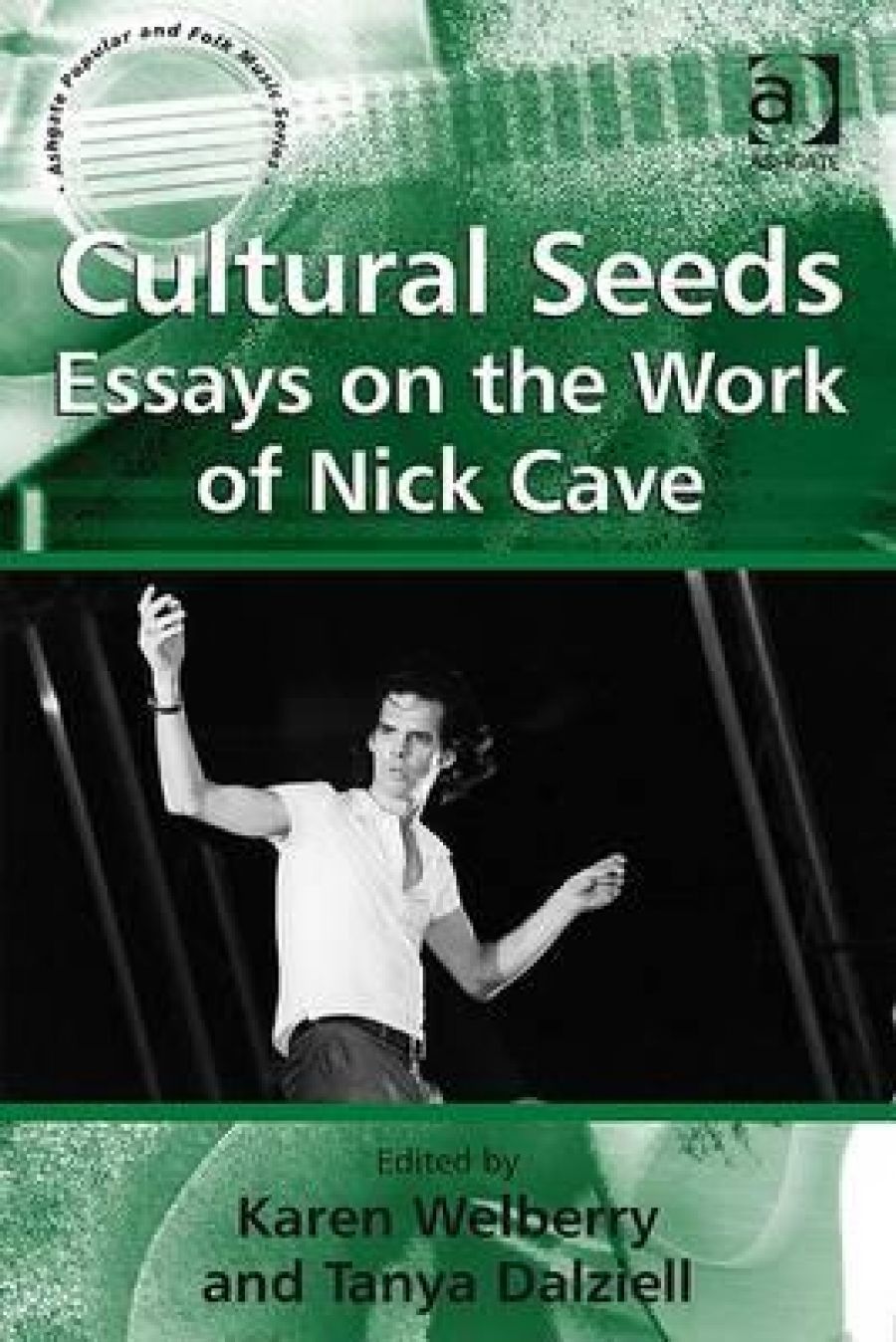
- Free Article: No
- Contents Category: Music
- Custom Article Title: Paul Genoni reviews 'Cultural Seeds' edited by Karen Welberry and Tanya Dalziell
- Review Article: Yes
- Article Title: Protean Cave
- Online Only: No
- Custom Highlight Text:
Nick Cave, against the odds, is one of the great survivors of Australian music. Cave, who made his first recording in 1978 and established his international reputation after moving to London in 1982, has experienced critical and popular success with a variety of musical ventures including The Boys Next Door, The Birthday Party, Grinderman and, most notably, The Bad Seeds. It is a measure of Cave’s durability that it is difficult to think of any other Australian rock act, with the exception of AC/DC, that has maintained an international profile for such an extended period. It is also salutary to consider how few of the international acts that emerged from the punk and post-punk moment of the late 1970s are still making high-profile and critically acclaimed music.
Cave’s ambitions have not been limited to music. As the dust jacket to Cultural Seeds proclaims, he is ‘now widely recognized as a songwriter, musician, novelist, screenwriter, curator, critic, actor and performer’. With the years, Cave has won a larger audience as the range and scope of his talent have been manifest in various forms of cultural production. His oeuvre includes works of fiction (And the Ass Saw the Angel, 1989; The Death of Bunny Munro, 2009) and a film script (The Proposition, 2005).
- Book 1 Title: Cultural Seeds
- Book 1 Subtitle: Essays on the work of Nick Cave
- Book 1 Biblio: Ashgate, $50 hb, 216 pp
Given the scope of Cave’s achievement and his obvious artistic ambition, it is no surprise that academic interest in his work has grown. Following Cave’s honorary doctorate from Monash University in 2008, this new collection of twelve essays addresses his myriad achievements. Most of the authors are drawn from Australian and international universities; the editors, Karen Welberry and Tanya Dalziell, are Australian academics.
What has made Cave’s work compelling, and provides a focus for these essays, is his ability to marry an omnivorous eclecticism to a consistent (and yet evolving) sensibility. Not that it is an easy task to encapsulate the core elements of Cave’s creative imagination, though these essays frequently invite readers to see him as an inheritor of literary traditions that pitch the sacred against the profane, the transcendent against the mundane. As Lyn McCredden writes, ‘What we find stamped across his songs, over and over, is the dark, lonely figure of a man caught up in desire for a divine source or balm’. It is a sensibility that is uncommon in Australia – particularly for one nurtured in Warracknabeal and Wangaratta – and when applied to specifically Australian settings (as in The Proposition), it has the effect of making the familiar seem alien and sinister, and that which is alien and sinister appear familiar.
Cave was, however, never likely to confine his vision to Australia. His punk roots had the effect of embedding him in the globalised youth culture of the time, and his subsequent artistic ambitions have been shaped by the international intellectual climate as he has moved between London, Berlin, and São Paulo. One virtue of this collection is that although several essays seek to contextualise the importance of Cave’s formative Australian years, there is no overt concern about his expatriate status. For these authors, the post-national imaginary is accepted and welcome.
With this in mind, it is pleasing to find two essays on Cave’s remarkable début novel, And the Ass Saw the Angel. These essays are a welcome contribution to the sparse commentary on a novel that has received scant critical attention because its ‘southern Gothic’ antecedents take it outside the frame-work of Australian literary criticism. Unfortunately, the essays collected in Cultural Seeds were written prior to the publication of The Death of Bunny Munro, an equally provocative novel, so unlike its predecessor, yet equally revealing of Cave’s creative intelligence.
Although the essays are grouped under three headings (‘Cultural Contexts’, ‘Intersections’, and ‘The Sacred’), this arrangement serves to provide only a loose organisational logic at best. It is not, of course, the intention of a collection such as this to provide a comprehensive overview of the artist’s output, and the editors appear to have given their authors a free hand in responding to selected aspects of Cave’s work. The result is a series of essays that address Cave’s work within the framework of their authors’ personal interests. This has resulted in some oddities, one being the tendency to focus on the peripheries of Cave’s output – his work with the one-album Grinderman attracts as much comment as his achievements with The Bad Seeds – but has the advantage of opening up new approaches to Cave’s work based on the enthusiasms of the authors. Whether it is McCredden on the sacred, Laknath Jayasinghe on dance, Nathan Wiseman-Trowse on Cave’s fascination with Elvis Presley, or editor Karen Welberry’s own essay on the forms of humour to be found in Cave’s work: the insights are consistently challenging.
The approach adopted by the editors and authors also has great merit in that it allows the collection to slough off the clichéd media responses to Cave’s work, which, stressing its violence, frequently resort to vague descriptions of Gothic. Whatever his occasional excesses and missteps, Cave’s ongoing career deserves to be understood in its full ambition, complexity, and range.


Comments powered by CComment